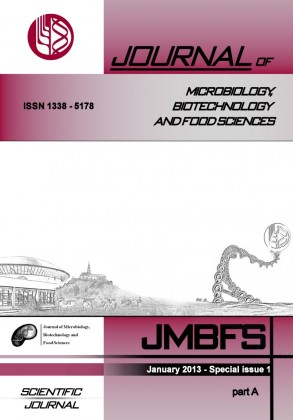STIMULATING AND PROTECTIVE EFFECTS OF VITAMIN E ON BOVINE SPERMATOZOA
Keywords:
vitamin E, spermatozoa, bulls, motility, CASA, MTT assay, NBT testAbstract
As spermatozoa are particularly sensitive towards oxidative damage, the search for a potential antioxidant substance to preserve and protect them under in vitro conditions has recently attracted the attention of the scientific community. The aim of this study was to assess the dose- and time-dependent in vitro effects of vitamin E on bovine spermatozoa during three different time periods (Time 0 h, 12 h and 24 h). Semen samples were collected from 15 adult breeding bulls, and diluted in physiological saline solution containing 0.5% ethanol (96%) together with 0, 10, 50, 100, 500 and 1000 µM of vitamin E. Spermatozoa motility was determined using the Sperm VisionTM and CASA (Computer Assisted Semen Analyzer) system. Cell viability was measured using the metabolic activity MTT assay, the nitroblue-tetrazolium (NBT) test was used to assess the intracellular superoxide formation. Spermatozoa motility differences between the control and groups A and B were the only one significant (P<0.05 and P<0.001, respectively) at 0 h, however, increased motility parameters were observed in all experimental groups after 12 h, with significant differences (P<0.001) after 24 h. The MTT assay indicated that none of the vitamin E concentrations had a negative or cytotoxic effect on the spermatozoa mitochondrial activity and furthermore showed a significantly (P<0.001) improved cell viability in groups B, C and D at 24 h. The NBT test showed that the addition of 500, 100 and 50 µM of vitamin E had an instant positive effect on the spermatozoa protection against free radical production. This protection remained present with a significant impact at 12 h (P<0.001 and P<0.05, respectively). Furthermore, all vitamin E concentrations exhibited significant (P<0.05; P<0.001) protective effects on the spermatozoa free radical formation. The results indicate that the addition of vitamin E, especially in concentrations of 500 µM to 50 µM to the culture medium could be beneficial for the overall stimulation of spermatozoa activity and protection against possible in vitro oxidative stress developAs spermatozoa are particularly sensitive towards oxidative damage, the search for a potential antioxidant substance to preserve and protect them under in vitro conditions has recently attracted the attention of the scientific community. The aim of this study was to assess the dose- and time-dependent in vitro effects of vitamin E on bovine spermatozoa during three different time periods (Time 0 h, 12 h and 24 h). Semen samples were collected from 15 adult breeding bulls, and diluted in physiological saline solution containing 0.5% ethanol (96%) together with 0, 10, 50, 100, 500 and 1000 µM of vitamin E. Spermatozoa motility was determined using the Sperm VisionTM and CASA (Computer Assisted Semen Analyzer) system. Cell viability was measured using the metabolic activity MTT assay, the nitroblue-tetrazolium (NBT) test was used to assess the intracellular superoxide formation. Spermatozoa motility differences between the control and groups A and B were the only one significant (P<0.05 and P<0.001, respectively) at 0 h, however, increased motility parameters were observed in all experimental groups after 12 h, with significant differences (P<0.001) after 24 h. The MTT assay indicated that none of the vitamin E concentrations had a negative or cytotoxic effect on the spermatozoa mitochondrial activity and furthermore showed a significantly (P<0.001) improved cell viability in groups B, C and D at 24 h. The NBT test showed that the addition of 500, 100 and 50 µM of vitamin E had an instant positive effect on the spermatozoa protection against free radical production. This protection remained present with a significant impact at 12 h (P<0.001 and P<0.05, respectively). Furthermore, all vitamin E concentrations exhibited significant (P<0.05; P<0.001) protective effects on the spermatozoa free radical formation. The results indicate that the addition of vitamin E, especially in concentrations of 500 µM to 50 µM to the culture medium could be beneficial for the overall stimulation of spermatozoa activity and protection against possible in vitro oxidative stress development.Downloads
Download data is not yet available.
Downloads
Published
2013-02-01
How to Cite
Tvrdá, E., LukáÄ, N., LukáÄová, J., Kňažická, Z., & Massányi, P. (2013). STIMULATING AND PROTECTIVE EFFECTS OF VITAMIN E ON BOVINE SPERMATOZOA . Journal of Microbiology, Biotechnology and Food Sciences, 2(special issue 2), 1386–1395. Retrieved from https://office2.jmbfs.org/index.php/JMBFS/article/view/7469
Issue
Section
Biotechnology
License
Copyright (c) 2013 Eva Tvrdá, Norbert LukáÄ, Jana LukáÄová, Zuzana Kňažická, Peter Massányi

This work is licensed under a Creative Commons Attribution 4.0 International License.
All papers published in the Journal of Microbiology, Biotechnology and Food Sciences are published under a CC-BY licence (CC-BY 4.0). Published materials can be shared (copy and redistribute the material in any medium or format) and adapted (remix, transform, and build upon the material for any purpose, even commercially) with specifying the author(s).

